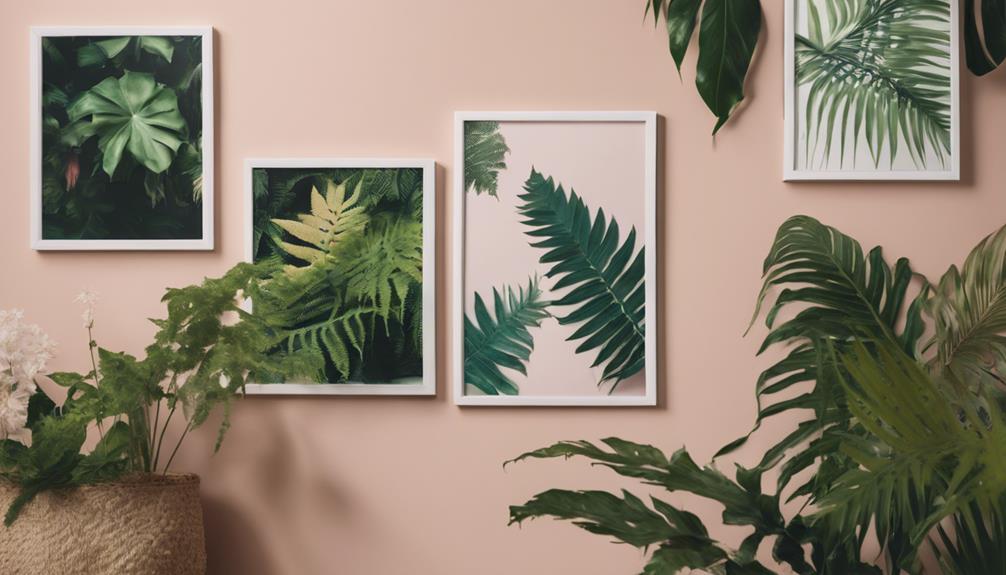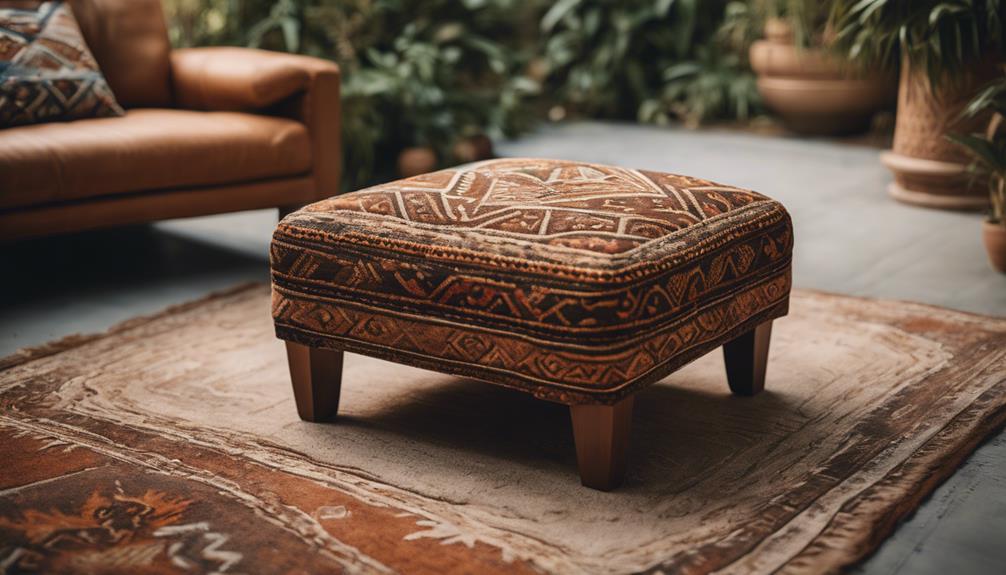Botanical prints can transform your walls into a collector's dream that reflects your personal style. You can hunt for unique pieces in local antique shops, thrift stores, or online platforms like Etsy. Each print tells a story, enhancing your decor while connecting you to nature. Don't forget to explore museum gift shops for exclusive finds. Frame your prints in aged gold or mix-and-match styles for a dynamic gallery wall. With a little creativity and effort, you'll create a harmonious display that sparks conversation. Want to uncover tips on sourcing those perfect prints and framing options?
Key Takeaways
- Explore old books, antique stores, and online marketplaces like Etsy for unique and affordable botanical prints to enhance your collection.
- Create a gallery wall by mixing vintage botanical prints with personal photos to showcase your individual style and interests.
- Use proper framing options, such as aged gold frames or budget-friendly choices, to elevate the aesthetic of your botanical prints.
- Regularly visit thrift stores and local markets for hidden treasures that can personalize and enrich your art collection.
- Emphasize the cultural significance of botanical prints as educational tools that celebrate nature and spark engaging conversations in your home.
Sources for Botanical Prints
You can discover unique botanical prints from various sources, including old books, online shops, and local antique stores.
Old books often hold hidden gems with illustrated pages that can be framed, transforming them into distinctive pieces of botanical art for your home. This vintage botanical print style adds character and charm to any room.
Online platforms like Etsy showcase extensive collections, such as those from LoveThePrint, featuring works from renowned naturalists. These prints cater to various tastes and can serve as striking focal points in your decor. Additionally, retailers like Target and Bed Bath & Beyond offer surprising selections of framed botanical prints, providing convenient options for those who prefer shopping in person.
Don't overlook local antique shops and Facebook Marketplace. These venues often have unique finds, including negotiable prices on vintage botanical prints that can enhance your collection. You can uncover rare pieces that tell a story while adding a touch of elegance to your walls.
Online Shopping Options

Exploring online shopping options opens up a world of botanical prints, allowing you to easily find unique pieces that suit your style and decor. Here are some great places to start your search for stunning wall art:
| Store | Highlights |
|---|---|
| Etsy | Vast selection of unique botanical illustrations |
| Frame It Easy | Affordable custom framing options for personalization |
| Target | Surprising selections of framed botanical prints |
| Museum Gift Shops | Exclusive botanical art and posters for unique gifts |
With these options, you can discover everything from artistic prints to framed pieces ready to hang. Online retailers often feature competitive prices and diverse selections, making it simple to find the perfect botanical prints to enhance your living space. Whether you're after a classic illustration or a modern interpretation, these platforms cater to various tastes and budgets. Plus, many shops offer easy browsing experiences, helping you curate your wall art collection effortlessly. Immerse yourself in the world of online shopping and transform your walls with beautiful botanical prints today!
Unique Finds and Shopping Tips
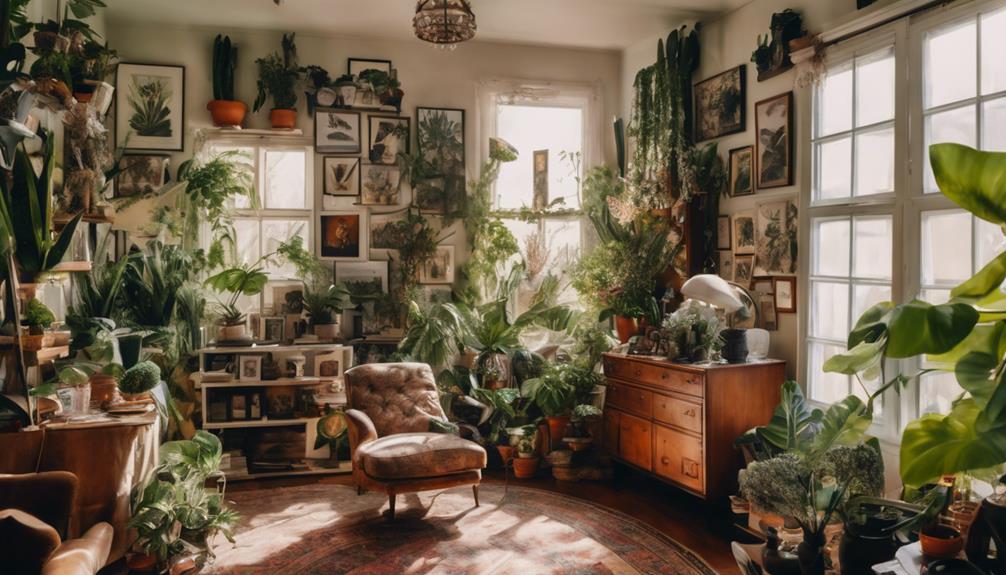
When you're on the hunt for unique botanical prints, antique shops can be goldmines for distinctive pieces at negotiable prices.
Don't forget to explore online marketplaces where you can find a variety of styles.
Remember, negotiating prices can lead to great deals.
With a little effort, you'll uncover treasures that perfectly fit your decor.
Antique Shop Treasures
Antique shops brim with vintage botanical prints that offer a unique selection, often impossible to find in mainstream stores. When you step inside, you'll discover a treasure trove of one-of-a-kind pieces that can elevate your decor. Many shops curate collections from local artists and estates, ensuring that each print tells its own story.
While hunting for that perfect addition to your unique collection, remember that prices are often negotiable. Don't hesitate to engage with shop owners; they can provide valuable insights about the history and significance of specific prints. This interaction can deepen your appreciation for your find.
Make it a habit to visit antique shops regularly. Their inventory changes frequently, meaning you never know when a hidden gem might appear. Each trip could yield unexpected surprises, allowing you to enhance your decor with distinctive botanical art.
With patience and a keen eye, you can build a stunning collection that reflects your personal style and love for botanical prints. So grab your shopping bag and get ready to uncover treasures that'll transform your walls into a collector's dream.
Online Marketplaces Exploration
Online marketplaces offer a treasure trove of unique botanical prints that can enhance your decor just like those found in antique shops. Platforms like Etsy showcase diverse collections from talented artists and renowned naturalists. You'll discover one-of-a-kind botanical illustrations that add a personal touch to your space.
Don't overlook local options, either. Websites like Facebook Marketplace often feature vintage botanical prints at negotiable prices, allowing you to build a budget-friendly art collection. For those looking for something ready-to-hang, retailers such as Target and Bed Bath & Beyond surprisingly carry framed botanical prints that cater to various decor styles.
When you find prints you love, consider how you'd like to display them. Websites like Frame It Easy and Framebridge offer affordable custom framing options, ensuring your botanical prints look their best. If you're searching for something truly unique, check out museum gift shops, where exclusive botanical art and posters await. Not only do you get stunning decor, but you also support cultural institutions.
With these online marketplaces at your fingertips, transforming your walls into a collector's dream is just a click away!
Negotiating Prices Effectively
Negotiating prices effectively can lead to significant savings and unique finds when you're hunting for botanical prints. Here are some strategies to keep in mind while exploring antique shops or markets:
| Strategy | Description | Benefits |
|---|---|---|
| Ask for Discounts | Don't hesitate to inquire about possible discounts. | Lower prices on prints. |
| Research Average Pricing | Know the average prices for similar prints before you go. | Informed offers during negotiations. |
| Build Rapport | Connect with shop owners; friendliness can yield discounts. | Better negotiation outcomes. |
| Buy in Bulk | Consider purchasing multiple prints; it might encourage deals. | More savings on total purchases. |
When negotiating prices effectively, remember that sellers appreciate engaged customers. If you're buying frames, that could also be a point for discussion to lower the overall cost. Keep an eye on seasonal sales and clearance events, as these can provide excellent opportunities to snag unique prints at reduced rates. With these tips, you'll elevate your collection without breaking the bank!
Importance of Botanical Art

Botanical art isn't just visually stunning; it carries cultural significance and celebrates nature's beauty in a unique way.
When you add botanical prints to your space, they not only enhance your decor but also spark interesting conversations.
These artworks remind us of our connection to the natural world, making them an essential addition to any home.
Cultural Significance of Botanicals
Recognizing the cultural significance of botanical art reveals its dual role as both an educational tool and a celebration of nature's beauty.
Historically, botanical art has served to document plant species, illustrating their medicinal and culinary uses across various civilizations. During the Age of Exploration, early botanical illustrations were essential for scientific study, aiding in the classification and understanding of plants.
Today, incorporating botanical art into your home decor does more than beautify your space; it brings a sense of tranquility and connection to the natural world.
These prints reflect a growing appreciation for nature in contemporary design, allowing you to create an inviting atmosphere. Beyond aesthetics, botanical illustrations often carry deeper meanings, symbolizing cultural narratives and environmental awareness.
Nature's Beauty in Art
Artfully capturing the essence of nature, botanical prints showcase the intricate beauty of plants while celebrating their cultural and historical significance. When you incorporate botanical art into your home decor, you not only invite the outside in but also enrich your living space with vibrant colors and detailed designs. Each framed print serves as a unique representation of nature, bringing life and character to your walls.
The timeless charm of botanical illustrations allows them to blend seamlessly with various decor styles, making them suitable for any room. Whether you choose a classic or contemporary look, these prints can elevate your environment, fostering a serene and inviting atmosphere. You'll find that the beauty of botanical art encourages an appreciation for nature, reminding you of the world outside.
Additionally, framed prints can act as subtle conversation starters, inviting discussions about nature, art, and personal interests. As guests admire your selection, they'll appreciate not just the aesthetic appeal but also the stories behind the plants. By showcasing botanical art, you create a space that reflects your love for nature and art, ultimately transforming your walls into a collector's dream.
Conversation Starters for Spaces
Incorporating botanical prints into your decor instantly turns your walls into engaging conversation starters, inviting guests to explore the beauty and significance of nature. These visually striking pieces of art encourage discussions about flora, cultural meanings, and even personal experiences related to plants. Their intricate designs, reminiscent of antique textbook pages, bring a timeless elegance that enhances your space while sparking curiosity.
When you frame botanical prints and arrange them thoughtfully, you not only beautify your home but also celebrate the rich history of plants in art and literature. This makes each piece a meaningful focal point that resonates with both you and your visitors.
The versatility of botanical prints further allows you to create a stunning gallery wall tailored to your unique style, showcasing your artistic preferences. As your guests admire your gallery wall, they'll appreciate the blend of aesthetics and storytelling. Each print can reflect personal connections or evoke shared memories, transforming your walls into an inviting space for meaningful conversations.
Ultimately, botanical art serves as a beautiful reminder of nature's role in our lives, making it an essential element in your home decor.
Benefits of Amazon Botanical Prints

Amazon botanical prints offer an affordable way to elevate your decor, making them perfect for budget-conscious decorators looking to enhance their spaces. These prints not only add a touch of elegance but also serve as a fantastic DIY project for personalizing your home.
| Benefit | Description | Impact |
|---|---|---|
| Affordability | Prices are accessible, fitting any budget. | Enhances decor without breaking the bank. |
| Versatile Styles | Complements various decor themes from modern to vintage. | Fits seamlessly into any room. |
| Support Local | Many prints come from small businesses in California. | Encourages local entrepreneurship. |
With a range of sizes, these prints can adapt to any space, whether you're creating a gallery wall or showcasing a standalone piece. Their design mimics antique textbook pages, providing a classic and timeless touch to your walls. So, if you're looking to refresh your decor affordably and stylishly, Amazon botanical prints are a perfect choice.
Characteristics of Botanical Prints

Botanical prints enchant with their intricate designs and timeless appeal, making them a perfect addition to any nature-inspired decor. These pieces of art often resemble antique textbook pages, showcasing the beauty of various plants and flowers in stunning detail. You'll find enchanting designs featuring ferns and floral patterns that evoke a sense of nostalgia and appreciation for nature.
Available in versatile sizes like 8×10 and 11×14, these prints cater to different wall areas and personal tastes, ensuring you'll find the right fit for your space. Their French Gray color offers a neutral touch that seamlessly blends with your existing decor elements, enhancing the overall aesthetic without overwhelming it.
When framed, botanical prints not only serve as beautiful decor but also become conversation starters, adding cultural and historical significance to your living space. Pairing them with black frames elevates their elegance, creating a striking contrast that draws attention to the intricate details.
Recommended Frames for Prints

Choosing the right frames can greatly enhance the presentation of your botanical prints, making them stand out in your space. Aged gold frames are a fantastic option—they offer a high-end look without breaking the bank. These frames complement the natural colors of your botanical art, creating an elegant display that enhances your decor.
If you're on a budget, keep an eye out for sale prices on frames. You can often find beautiful options at a fraction of the regular price, allowing you to create a stunning display without exceeding your budget. Many frames come with pre-attached hanging hardware, making installation a breeze for those who prefer a DIY approach.
Consider mixing and matching different styles and sizes to create a unique presentation. This not only adds visual interest but also allows you to showcase multiple prints cohesively. The right frames can transform your guest room decor, helping your botanical prints blend seamlessly with the overall design theme.
Whether you choose classic or modern frames, remember that a well-framed print can elevate the entire room, turning your walls into a collector's dream.
Gallery Wall Creation and Aesthetics
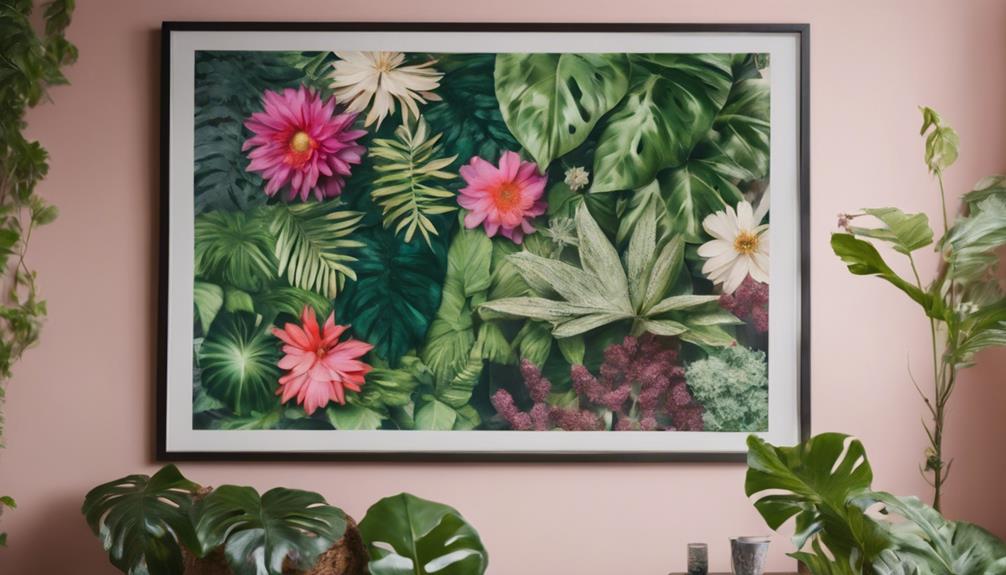
Creating a gallery wall with your framed prints not only fills empty spaces but also transforms your room into a vibrant showcase of art and personal style. To enhance the overall aesthetics, consider mixing vintage botanical prints with your personal photographs. This unique blend adds a touch of individuality while maintaining a cohesive design.
When arranging your gallery wall, use consistent color palettes among your framed botanical prints to create a harmonious visual flow. This simple step can tie different elements together, making the display feel deliberate and well thought out. You can also keep things fresh by regularly updating your gallery wall with seasonal botanical prints. This practice not only keeps your decor dynamic but also engages anyone who enters the room.
Thoughtfully curated gallery walls serve as conversation starters, showcasing your personal collections and interests. As you add new pieces, think about how they relate to your existing prints, creating a narrative that reflects your style. With careful planning, your gallery wall won't just beautify your space but also invite admiration and discussion, making it a true collector's dream.
Thrifting and Art Collection
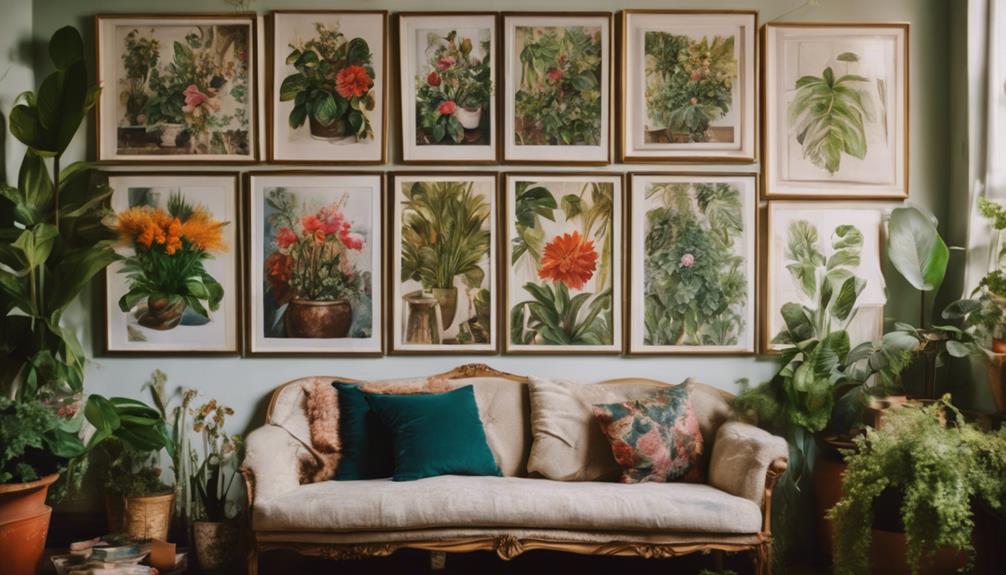
Thrifting for art offers a treasure hunt experience where you can discover unique pieces that elevate your collection without overspending. Thrift stores like Goodwill often stock a diverse range of affordable artwork, including original paintings from local artists that can enhance your art collection without breaking the bank.
You'll find donated pieces that feature attractive designs and quality framing, making them distinctive additions to your collection. When focusing on nature-themed art, such as botanical prints, you can create a universally appealing collection that resonates with you personally.
Let your local surroundings inspire your thematic collection ideas. You might find urban artwork depicting architecture or travel-themed art featuring landmarks, both of which enhance your connection to the pieces.
Regular visits to thrift stores and local markets can yield hidden treasures in the form of botanical prints, allowing you to curate a unique and personalized art collection.
Conclusion
So, as you curate your collection of botanical prints, imagine your walls blooming with life, each piece a whispered secret from nature.
You'll find the perfect frame, and suddenly, your living room transforms into a lush greenhouse, where sunlight dances through leaves and colors pop like a summer garden.
With each print, you're not just decorating; you're inviting a vibrant world indoors, creating a sanctuary where art and nature coalesce in beautiful coincidence.
